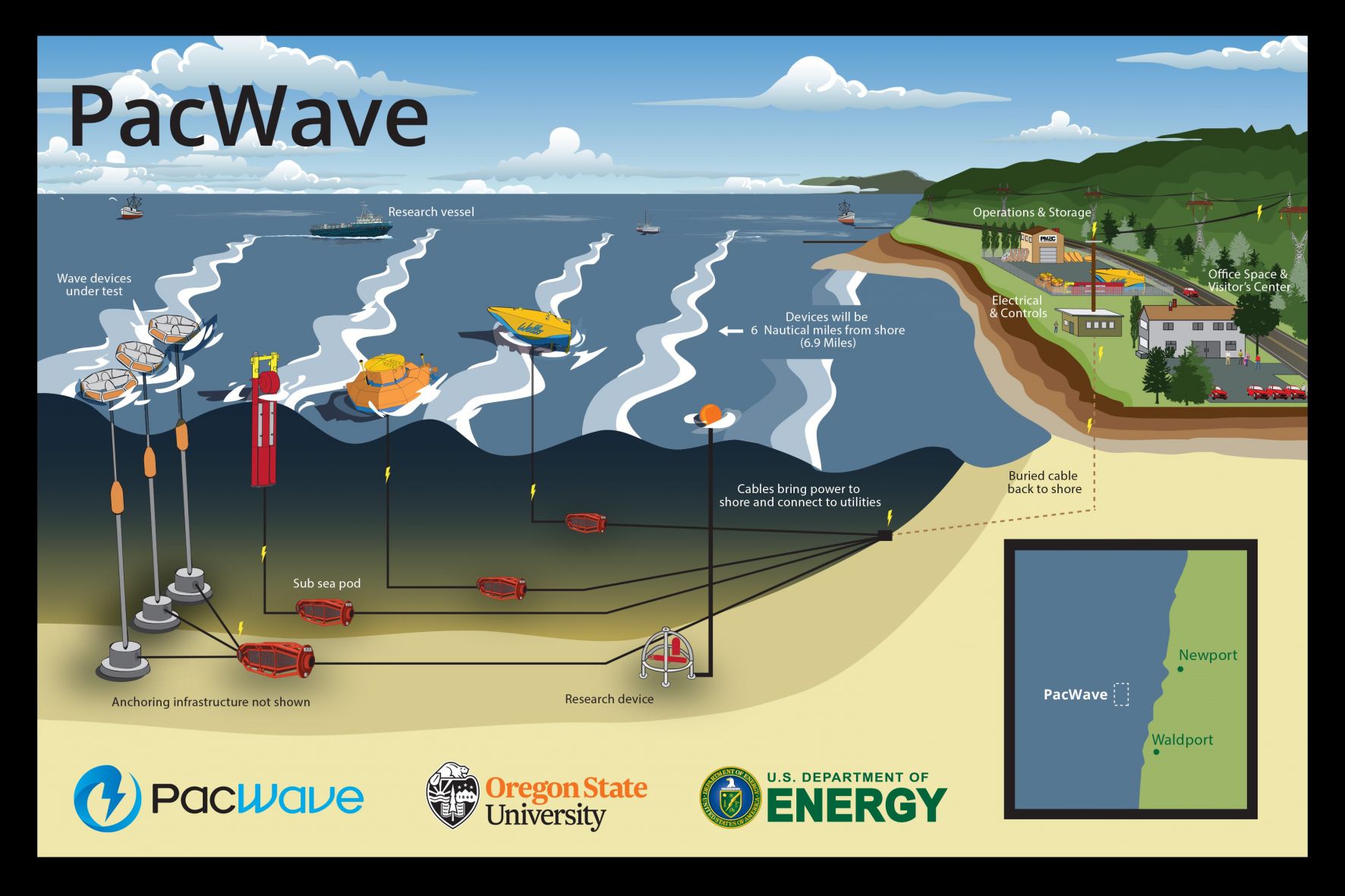The open ocean is an unforgiving judge of engineering prowess. Salty seawater, gale-force winds and relentless, punishing waves resist entrepreneurs’ determination to install power-generating devices in the water. The scale of that challenge is reflected in the marine energy industry's poor track record to date.
Offshore wind turbines operate in harsh conditions, but they do so largely above the waterline. Marine energy devices, on the other hand, are exposed to the full force of the ocean’s ferocity by floating atop or below the waves. At the end of 2019, there were just 531 megawatts of wave, tidal and other marine energy technologies installed globally, according to the International Renewable Energy Agency.
But the fledgling marine energy industry will soon get a boost in the United States. Oregon State University’s PacWave testing facility is in its permitting home stretch and could begin construction this year. The project has received $35 million from the U.S. Department of Energy (DOE) and $3.8 million from the state government of Oregon.
In the works since 2013, PacWave will comprise four wave-energy testing berths at a site located about seven miles from shore on Oregon’s Central Coast. Each berth will have its own transmission cable, and the testing site will come pre-permitted for different types of technologies. PacWave is a not-for-profit project operated by a team based at Oregon State University’s College of Earth, Ocean, and Atmospheric Sciences.
The facility fills a hole in the U.S. marine energy development pipeline, Dan Hellin, PacWave’s deputy director, said in an interview. “One of the issues is, there are very few places where you can do full-scale, open-water testing."
PacWave's first wave-energy conversion devices could be in the water by late 2022 or early 2023, Hellin said, assuming construction of the onshore utility connection and monitoring facility and installation of the subsea transmission cables proceed as planned. The testing facility could feed up to 20 megawatts of power to the onshore grid at full capacity.
“Being able to prove the technology out in the open ocean, particularly in the ocean of Oregon, where the conditions are pretty demanding, is a good way of showing that the technology is viable and has a high level of survivability to be economically viable,” said Hellin.
Prepping the PacWave project pipeline
Manufacturers of wave energy converters — devices that capture the energy contained in waves and convert it to electricity — will pay berthing fees to use the facility. Hellin said the goal is for client berthing fees to offset much of PacWave’s operating costs and for the project eventually to be self-funding.

Credit: U.S. Department of Energy
The project’s design was based on input from developers as well as partners such as the European Marine Energy Centre, a wave and tidal power test and research center based in Scotland’s Orkney Islands. PacWave is the culmination of a years-long effort by the Department of Energy. “DOE had been contemplating the idea of an offshore, grid-connected test site off the Pacific Coast for, well, probably 10 years,” Hellin said.
Once the facility is finally ready and waiting, the challenge for DOE and the PacWave team will be helping to foster a pipeline of companies ready to deploy devices. Of the companies to have tested devices at the European Marine Energy Centre, several have gone bankrupt, including Pelamis and Aquamarine Power, and none have yet found a path to commercial viability.
Last October, DOE awarded funding to developers to complete designs for wave-energy devices in preparation for open-water testing at PacWave. Oakland, California-based CalWave Power Technologies will design a 45-kilowatt version of its submerged pressure differential device. And a team from Minneapolis based engineering consultancy Idom will build a next-generation version of its oscillating water column wave-energy converter.
“It takes a developer multiple years to run through the development cycle from computer-based modeling up through small-scale lab testing to wave tank testing to small-scale, open-ocean testing to what we’re really looking at for PacWave, which on the utility scale would be pretty close to precommercialization devices,” said Hellin.
“Part of the challenge,” he went on, “is to have these developers moving through that process and ready for the open-water testing when the test site is available.”
Potential commercial applications for remote communities
One of the longstanding challenges of the marine-energy industry is the lack of design consensus.
More than 170 wave energy converters have been designed, but less than 20 percent have resulted in a full-scale prototype, according to the European Commission (PDF). The immaturity of the technology and shortage of utility-scale deployments mean that developers have not yet been able to reduce costs to the point where wave energy is competitive with other renewable energy technologies.
Even so, islands or isolated coastal communities with burdensome energy costs are a potential market today.
“One of the areas of interest,” said Hellin, “is smaller-scale applications in remote communities in places like Alaska where they may be running on diesel generators to generate electricity to offset those incredibly high costs of energy.”
Despite the challenges, the attributes of wave energy — predictable, reliable and carbon-free electricity that can be deployed close to load centers — explain why entrepreneurs and engineers continue to try to commercialize the technology.
“The wave-energy industry has ebbed and flowed," Hellin said. "But there’s a number of developers who are definitely moving toward full-scale commercial devices. As more devices get into the water and are tested, confidence in the industry is going to grow.”




